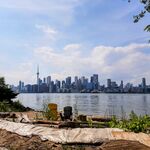W. K. Lis
Superstar
Excluding the zoo, a park-n-ride & a kiss-n-ride & Durham Transit bus transfer bays could be attached close to one of the east most stops of a LRT for Durham region passengers.
Operational loss of $10 m per year is believable.
However, that translates to a subsidy per ride: $10 m / 15 m rides = $0.67 per ride.
Obviously, then the total cost per ride (= fare recovery + subsidy) cannot be $17, or even $10. It should be in the $2 to $4 range.
It was a publicity stunt by Giambrone, to justify the decision to instead hike fares. TTC staff quickly took the idea off the table when they realized that they'd still have to maintain the mothballed stations, and that they'd have to suddenly find a lot of buses to provide replacement service, costing more than the cost of simply operating the subway.Wasn't there talk about closing the subway a few years ago?
How do you know that? What is the reference? The TTC seems to think differently.I know Sheppard would be first on the chopping block if the TTC ever has budget problems. In fact, I'd rather close or reduce service on Sheppard than impose fare hikes.
What it should be and are, are 2 different things. $17 has been used not only by TTC, but by people who know first hand within City Hall.
75% of riders who use the line have already paid their fare elsewhere within the system and that most likely on the low end. Therefore that leaves very few riders paying the revenue to cover the cost ratio.
It has been said by people in the know within TTC that the subway would be close if it came to a major cash crunch for TTC.
$17 average per human rider per year, you mean? That sounds like $67M budget divided by Toronto's population, doesn't it?What it should be and are, are 2 different things. $17 has been used not only by TTC, but by people who know first hand within City Hall.
Excluding the zoo, a park-n-ride & a kiss-n-ride & Durham Transit bus transfer bays could be attached close to one of the east most stops of a LRT for Durham region passengers.
Why if it costs more to run replacement buses than run the subway. where would you get the extra buses?What I was saying was that for me, the Sheppard Subway would be first on the chopping block if there was a budget crunch.
Why if it costs more to run replacement buses than run the subway. where would you get the extra buses?
Because they hadn't done the math yet when it came out of Giambrone's mouth. If you recall, they quickly dropped that one from consideration. If you recall, we discussed it here at the time.Will it cost more? Why would the TTC consider shutting it down if it would cost more?
The 510 ridership isn't as concentrated at peak as Sheppard. Also, most of the 510 Spadina service is on the 2.5 km from King to Bloor, compared to the 5.5 km from Yonge to Don Mills.That said, I would be surprised it it costs more to run replacement buses. Remember, the Sheppard Subway moves less people than the 510 Spadina. When the 510 Spadina was offline for construction, the buses were able to handle it without needing an obscene amount of vehicles.
Will it cost more? Why would the TTC consider shutting it down if it would cost more?
That said, I would be surprised it it costs more to run replacement buses. Remember, the Sheppard Subway moves less people than the 510 Spadina. When the 510 Spadina was offline for construction, the busses were able to handle it without needing an obscene amount of vehicles.
There isn't much evidence that the growth to date is increasing ridership. If you compare the 2009 daily ridership to the 2013 daily ridership, it has only grown by 550 riders from 47,700 to 48,250. Presuming that each rider travels both ways each day, that's only 225 people.Also keep in mind that ridership projections should be based on future potential ridership, not just existing ridership. The Sheppard subway line opened in 2002 and now, 13 years later, there are still a number of massive new developments in the works. Those developments are located on Sheppard only because of the subway.
Even if we assume that Sheppard subway does not bring any revenue at all, its cost per ride cannot be $17 or even $10.
If it was $10 per ride, it would mean that TTC spends 9% of its yearly budget to run Sheppard subway. If it was $17, TTC would spend 15% of its yearly budget to run Sheppard subway.
I don't know how they produced that $17 number, but it does not pass a simple sanity test.
Ridership Grows Slowly
Initially, ridership on the University Subway was lighter than expected. Most passengers found the Yonge Subway to be a more direct route, offering downtown stations closer to their destinations. Trains were often short-turned at Union Station, and finally, on June 23, 1969, the TTC discontinued service entirely after 9:45 p.m. on Mondays to Saturdays and all day on Sundays and holidays. The 5 AVENUE ROAD bus operated a 5B branch between Eglinton and Front Street whenever the University Subway did not operate, with side-jaunts to St. George station to capture passengers from the Bloor Subway. This arrangement remained in place until 1978, when the Spadina Subway opened for service.




